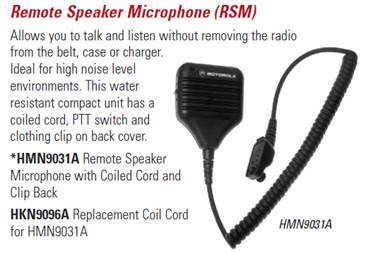CLCC RADIO 101 – More than you ever wanted to know about CLCC’s radios
Definitions
- Portable Radio – A hand held radio. CLCC hand held radios are Motorola GP350 UHF radios. Other model radios can be used if programmed correctly.
- Mobile Radio – A radio installed in a vehicle. CLCC mobile radios are Motorola GM300 UHF radios. Other model radios can be used if programmed correctly.
- CLCC radio channels (see chart below)
- Channel 1: simplex and talk around for repeater channel 2
- Channel 3: simplex and talk around for repeater channel 4
- Channel 5: simplex and talk around for repeater channel 6
- Channels 2, 4, & 6 repeater channels (Comms not possible without a repeater)
- Channels 7 – 16 simplex channels
- Simplex Channel – Also called “Direct” or “Car-to-Car”. A channel in a radio that is configured to transmit and receive on the same frequency. Communication is from radio to radio. For example, CB radios operate in a simplex mode. CLCC radios are programmed so that channels 1, 3, 5 and 7 – 16 are simplex channels. See diagram below.
- Repeater Channel – Also called a “duplex or half duplex channel”. A channel in a mobile/portable radio that is configured to transmit and receive on different frequencies. For example: CLCC channel 2 transmits on 462.550 MHz and receives on 467.550 MHZ. Radio to radio communication on a duplex/repeater channel can only be accomplished through a repeater. If you are outside the range of the repeater or there is no repeater, you will not be able to communicate on a repeater channel. CLCC channels 2, 4 & 6 are repeater channels.
- Repeater – A radio relay device that receivers on one frequency and transmits on another frequency. When the repeater receiver receives a signal from a mobile or portable radio, the audio is automatically transmitted on the repeater’s transmit frequency. For example, the CLCC channel 2 repeater receives on 462.550 MHZ (mobile/portable radio channel 2 transmit frequency) and transmits on 462.550 MHz (mobile/portable radio channel 2 receive frequency). Repeaters are typically located on towers or mountain tops and used to extend the range of mobile/portable radios. See diagram below. CLCC channels 2, 4 & 6 are repeater channels.
- Talk-Around – Also called Repeater Talk-Around. A channel in a radio that is configured to operate in simplex mode on the same frequency as the repeater’s transmitter. CLCC channels 1, 3 & 5 are Talk-Around channels. Channel 1 is talk-around for the channel 2 repeater. Channel 3 is talk-around for the channel 4 repeater. And, channel 5 is talk-around for the channel 6 repeater. Why do this? It is the best of both worlds. Since the mobile/portable radio’s receive frequency is the same for both the simplex and repeater channels (i.e. the frequency for both CLCC channel 1 (simplex) and channel 2 (repeater) is 462.550 MHz) a mobile/portable radio can listen to both simplex channel conversations and repeater conversations without having to change channels. Switching between simplex channel (i.e. channel 1) and the repeater channel (i.e. channel 2) selects which frequency the radio will transmit on – simplex or repeater.
- Carrier Squelch – A circuit that mutes receiver noise until a signal is received. When a signal is received, the squelch circuit enables the speaker so the audio can be heard. For example, CB radios use carrier squelch.
- Coded Squelch – There are two types of coded squelch – tone and digital. Tone squelch is known as Continuous Tone Coded Squelch (CTCSS) or PL (Private Line, a Motorola trade name for CTCSS). Digital squelch is known as Digital Coded Squelch (DCS) and DPL (Digital Private Line a Motorola trade name DCS). CLCC radios use CTCSS (100.0 Hz) on channels 1 & 2 and DCS (612) on channels 3 – 16.
- Why use coded squelch? – Radios are programmed with coded squelch so multiple different groups of radio users can share the same frequency and not have to listen to each other’s conversations. Each group uses a unique squelch code (CTCSS or DCS). The transmitters are programmed to automatically send the group specific squelch code. Only those receivers programmed with the same code will unsquelch and “hear” the transmission. Receivers with different codes will not unsquelch – no audio heard. With coded squelch, radio operators sharing a frequency do not hear conversations from other groups. The exception to this is when different groups coincidently happen to be in the same area, at the same time and have the same squelch code. If this happens, switch to a different channel. Do to the limited number of frequencies available for personal and business use, they have to be shared.
- With shared frequencies there is always the possibility that a conversation using a different squelch code may be in progress. Before transmitting, the radio operator should make sure there is no conversation in progress by other users of the frequency with a different squelch code. On the GP350 portable radios this can be done by disabling coded squelch by pushing side button which switches the receiver into carrier squelch mode, also known as monitor mode. While in monitor mode the receiver will “hear” every conversation on the frequency. An alternative is to look at the LED on the radio. If it is flashing, there is another user transmitting on the frequency with a different squelch code. The LED will flash whenever the receiver is receiving a signal with a different squelch code. See LED chart below.
- LED Indicator
- Transmitting – solid red
- Transmitting with low battery – flashing red and tone
- Receiving (with or without the same squelch code) – flashing red
- After transmitting or changing channels with coded squelch off – orange momentarily
- Time-out Timer (TOT) – The radio has a time-out timer to prevent long duration transmissions. After transmitting for about 30 seconds the radio will make a tone and stop transmitting. If this happens, release the Push to Talk (PTT) button to reset the timer and then press the PTT button again to resume your transmission. The purpose of the timer is to prevent continuous transmission if you accidentally place the radio in such a position that the PTT button is depressed accidentally.
- Lingo – To make sure you sound like a radio geek, please use the proper terminology.
- It is called a Portable Radio NOT a Walkie Talkie
- Insects have antennae. Vehicles and radio towers have antennas
- Hertz is the same as Cycles per Second (CPS). Heinrich Rudolf Hertz (1857 – 1894) was a German physicist who first conclusively proved the existence of electromagnetic (radio) waves. Hertz is used instead of CPS to honor Heinrich’s contributions to the radio world.
- PL is the common term for Continuous Tone Coded Squelch System (CTCSS), DPL is the common term for Digital Coded Squelch (DCS). Just like Xerox is the common term for photocopy.
- Land Mobile Radio (LMR) is the professional term for two-way radio systems. LMR usually refers to a two-way radio infrastructure supporting a large area (state police), large user group (FedEX) and/or an urban area (NYPD).
How it all works
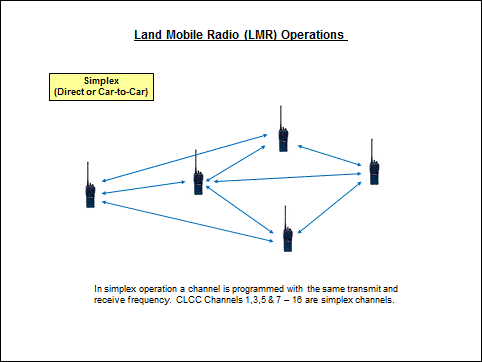
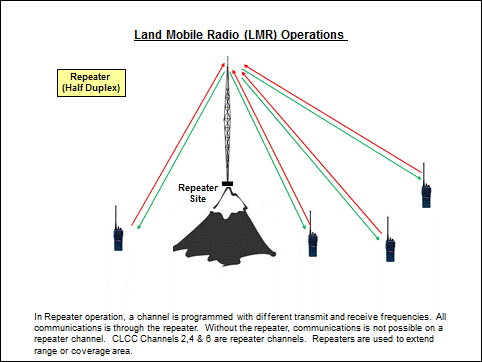
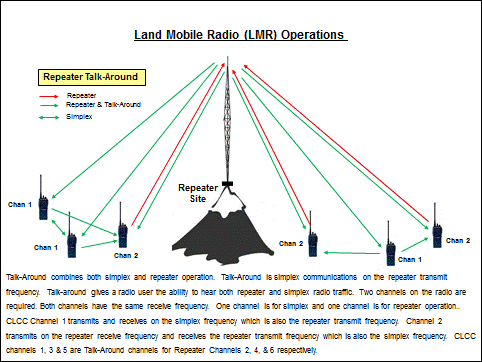
CLCC Frequencies
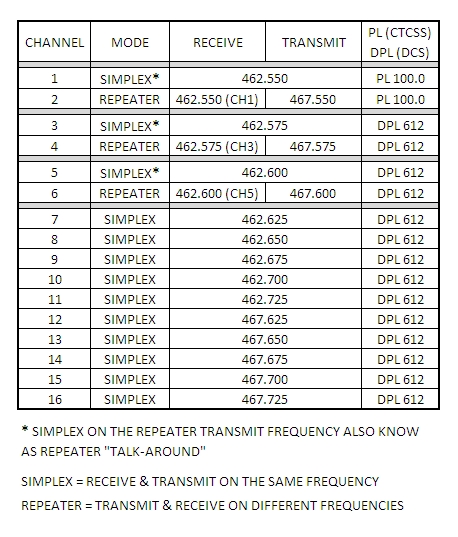
- CLCC radio channels
- Channel 1: simplex and talk around for repeater channel 2
- Channel 3: simplex and talk around for repeater channel 4
- Channel 5: simplex and talk around for repeater channel 6
- Channels 2, 4, & 6 repeater channels (Comms not possible without a repeater)
- Channels 7 – 16 simplex channels
Motorola GP-350 Portable Radio Buttons
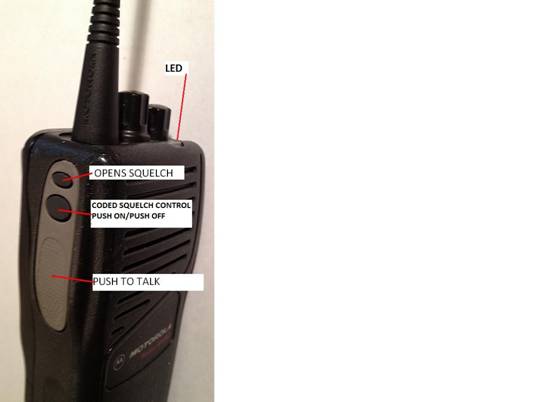
LED Indicator
- Transmitting – solid red
- Transmitting with low battery – flashing red
- Receiving – flashing red
- After transmitting or changing channels with coded squelch off – orange momentarily
Radio Info:
· Motorola GP-350 UHF 16 Channels
· Model: P94MGC20C2AA
Accessories:
· Single unit charger HTN 9042A
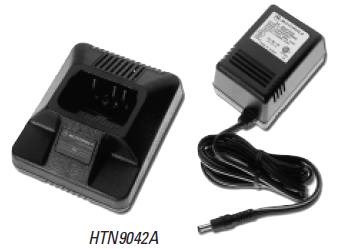
· HTN9630C 6 Unit Charger
